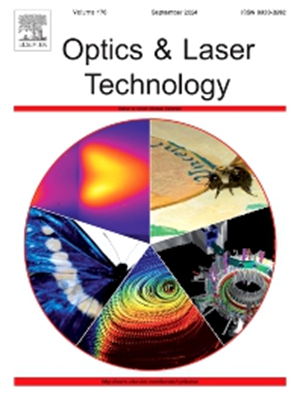Snapshot high dynamic range imaging based on adaptive frequency stripe masks
IF 4.6
2区 物理与天体物理
Q1 OPTICS
引用次数: 0
Abstract
A novel snapshot method based on adaptive frequency stripe masks is proposed to realize high dynamic range (HDR) imaging for highly reflective surfaces. The high refresh rate of the digital micromirror device is used to load modulation masks, and superimposed modulation of the target scene is performed to achieve snapshot HDR imaging by using a single superimposed image. Adaptive frequency stripe masks are generated based on the energy spectrum of the scene to enhance the lateral resolution of the demodulated sub-images. Then the sub-images are separated through a frequency domain reconstruction algorithm, and the final HDR image is obtained by using a multi-exposure image fusion technique. Experimental results demonstrate that the proposed method produces ghost-free HDR images with enhanced lateral resolution and contrast while effectively avoiding overexposure and underexposure. This approach provides a valuable solution for visual imaging of highly reflective surfaces.
基于自适应频率条纹掩模的快照高动态范围成像
为了实现高反射表面的高动态范围成像,提出了一种基于自适应频率条纹掩模的快照方法。利用数字微镜器件的高刷新率加载调制掩模,利用单幅叠加图像对目标场景进行叠加调制,实现快照式HDR成像。基于场景的能量谱生成自适应频率条纹掩模,以提高解调后子图像的横向分辨率。然后通过频域重构算法对子图像进行分离,利用多曝光图像融合技术得到最终的HDR图像。实验结果表明,该方法能够产生无鬼影的HDR图像,提高了横向分辨率和对比度,同时有效地避免了曝光过曝和曝光不足。这种方法为高反射表面的视觉成像提供了有价值的解决方案。
本文章由计算机程序翻译,如有差异,请以英文原文为准。
求助全文
约1分钟内获得全文
求助全文
来源期刊
CiteScore
8.50
自引率
10.00%
发文量
1060
审稿时长
3.4 months
期刊介绍:
Optics & Laser Technology aims to provide a vehicle for the publication of a broad range of high quality research and review papers in those fields of scientific and engineering research appertaining to the development and application of the technology of optics and lasers. Papers describing original work in these areas are submitted to rigorous refereeing prior to acceptance for publication.
The scope of Optics & Laser Technology encompasses, but is not restricted to, the following areas:
•development in all types of lasers
•developments in optoelectronic devices and photonics
•developments in new photonics and optical concepts
•developments in conventional optics, optical instruments and components
•techniques of optical metrology, including interferometry and optical fibre sensors
•LIDAR and other non-contact optical measurement techniques, including optical methods in heat and fluid flow
•applications of lasers to materials processing, optical NDT display (including holography) and optical communication
•research and development in the field of laser safety including studies of hazards resulting from the applications of lasers (laser safety, hazards of laser fume)
•developments in optical computing and optical information processing
•developments in new optical materials
•developments in new optical characterization methods and techniques
•developments in quantum optics
•developments in light assisted micro and nanofabrication methods and techniques
•developments in nanophotonics and biophotonics
•developments in imaging processing and systems

 求助内容:
求助内容: 应助结果提醒方式:
应助结果提醒方式:


